Health Articles
Find out more about your health here from our health professionals!
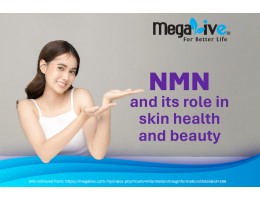
NMN and Its Role in Skin and Beauty Health
Nicotinamide mononucleotide (NMN) has garnered attention for its potential to support cellular health and promote overall beauty, particularly in skin rejuvenation. NMN serves as a precursor to nicotinamide adenine dinucleotide (NAD+), a critical coenzyme involved in energy metabolism and cellular repair processes.
Research highlights its potential in improving skin health by reducing oxidative stress, inflammation, and signs of aging. For instance, NMN has been shown to protect human skin cells from damage induced by environmental stress by reducing reactive oxygen species (ROS) while restoring DNA-repairing enzymes.
Additionally, NMN supports collagen production and enhances skin elasticity, which can combat wrinkles and dullness. By boosting NAD+ levels, NMN also improves mitochondrial function, crucial for maintaining youthful, radiant skin.
Skin Health Benefits
NMN’s ability to enhance NAD+ levels provide several skin-related benefits:
- Collagen Production: NAD+ is crucial for collagen synthesis, which maintains skin elasticity and firmness. Higher NAD+ levels can lead to more youthful and resilient skin.
- DNA Repair: NMN aids in repairing skin damage caused by UV exposure and environmental stressors, helping to reduce wrinkles and prevent premature aging.
- Skin Barrier Support: By improving lipid production, NMN enhances the skin’s barrier function, aiding in hydration and protection.
Beauty Beyond Skin
NMN’s role in activating sirtuins, proteins associated with longevity, extends its benefits to overall beauty. These proteins help regulate inflammation, improve pigmentation issues, and contribute to even skin tone.
Patented NMN form (Uthever®)
The Uthever® NMN formulation, specifically used in supplements, has been clinically tested. In a study of 66 participants, it demonstrated a significant 38% increase in NAD+/NADH levels after two months, suggesting its efficacy in boosting cellular energy and supporting anti-aging processes.
Conclusion
While NMN shows promise in enhancing skin health and beauty, it is important to consult a healthcare practitioner before using NMN supplements. Factors such as existing health conditions, medications, or other supplements may influence its suitability for individual use.
References
- Chang TM, et al. Int J Mol Sci. 2022;23(14):7539. DOI: 10.3390/ijms23147539.
- Ekström IA, et al. Environ Int. 2020;143:105974. DOI: 10.1016/j.envint.2020.105974.
- NMN and its potential in skin health: Phytogenious
- Uthever® NMN clinical trial data: Uthever Official
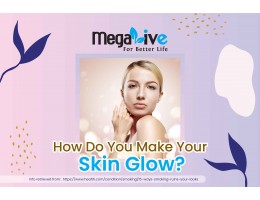
How do you make your skin glow?
There are many factors influencing skin condition, but in this post, we are going to share on tips on how to make your skin glow!
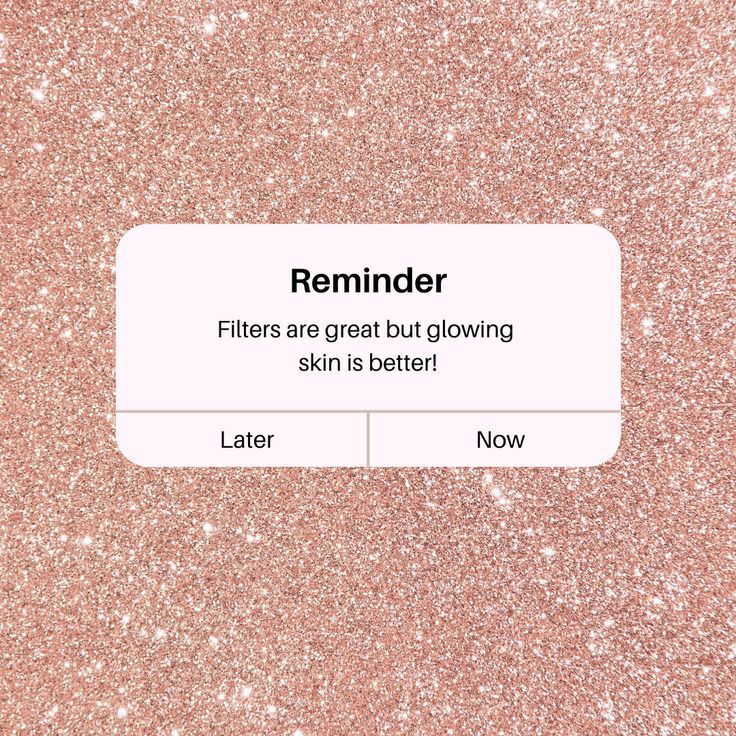
As much as smoking is bad to your lung so does it to your skin
Cigarette smoke contain many harmful substances to our body, as we know. However as for the skin, it releases carbon monoxide which displace oxygen in your skin and nicotine which reduce blood flow which will make skin dry and discolored. Smoking also triggers the destruction of collagen in the skin hence skin loss its elasticity and produce wrinkles and fine lines!
When you are younger and a smoker you cannot really see the difference but as you get older, the damage on your appearance will be obvious and you will be looking older as compared to your actual age (1).

Sunscreen is a must
Malaysia is a humid and warm country all year long; thus, wearing sunscreen is a must! Sunscreen helps protect skin from premature ageing like wrinkles, fine lines, and hyperpigmentation. Studies show that people who are under 55 years old and wear sunscreen regularly can lower their risk of premature ageing by 24% as compared to those who wear sunscreen occasionally or not at all.
If you are a newbie looking for sunscreen, look for sunscreen with at least SPF 30 (Sun Protecting Factor) and choose sunscreen according to your skin type, such as aqua sunscreen, which is meant for dry skin, etc. You also must apply sunscreen every 2 hours or after exercise. Sunscreen should also be applied at least 30 minutes before going out, as it requires time to be absorbed by the skin and activated in order to protect your skin (2).
Move, Move, Move
We know that exercising regularly can keep our bodies fit and healthy, but did you know that it can also keep your skin healthy?
Exercise increases blood circulation and flow throughout the body, hence making your skin radiant and glowing. Pssttt…you can kill twoi birds with one stone by doing this; you can keep your body lean while also getting healthy skin! (3)
Keep your body hydrated
Our skin is exposed to various conditions: cold due to the air conditioner, warm due to the water, etc., so drinking plenty of water will make our skin condition better. Everybody is born with a particular skin type, whether it is dry, oily, or a combination; however, all these surrounding factors and age factor can change skin condition as well (4, 5).
In order to see whether your skin is dry, try to pinch it in an area and see whether it has a wrinkle on it after your pinch or whether it bounces back after your pinch, which is an indicator for well-hydrated skin. Wrinkles and less bouncy skin are indicators of dry skin; it can also sometimes be seen based on your urine colour if it is too concentrated, meaning your body does not get a sufficient amount of water (4, 5).
Lifestyle changes can reverse this; drink at least 8 glasses of water per day. Limiting the intake of alcohol and drinking less caffeinated drinks like coffee and tea can improve the dry skin condition (4).
Face and manage your stress.
We used to believe that suppressing our feelings and emotions was better for everyone, including ourselves. However, that is not always the case; we have to deal with it and manage it. Talk to someone if you have a problem; share it with someone that you trust. Think positive.
Pick up some hobbies, distract yourself from overthinking about it, and slowly find solutions. Doing outdoor activities can help calm a person if their mind is too saturated with a lot of stuff, or spending time alone can de-clutter their mind and create more space. Cleaning can sometimes make you a lot happier and help you think better about the solution to your problem.
Established a skincare routine
Skin care is essential for keeping skin in good condition. A good skin care routine will improve skin condition, but only if the products used are of high quality.First, you have to find out your skin type. Normal skin, dry skin, oily skin, and combination skin are the four skin types.
To determine your skin type, start by washing your face and then waiting an hour. After it’s been an hour, dab your forehead and nose with a tissue and check to see if any oil has rubbed off. If it did, it’s a sign that you have oily skin. If there isn’t any oil but your face feels dry and tight, you may have dry skin (4,5).
Once you have figured out your skin type, find the right product for it. The common one should have cleanser, moisturizer, toner, sunscreen, exfoliator, and makeup removal. Start with cleansing your face at least twice per day. If you need to exfoliate your skin at least twice a week, this is a good time to remove all of the dead cells, dirt, and blemishes on your face (5).
Once you have done these, your skin is now ready to absorb all the good nutrients from your skincare, so now is the time for you to apply toner and moisturizer. Toner and moisturiser are good for hydrating the skin. After that, the skin is completely moisturized.You can now apply sunscreen.After sunscreen, it is time for you to wear makeup. If you are wearing make-up, make sure to thoroughly clean it at the end of the day using make-up removal and start your nighttime skin care routine as per daytime (5).
The only difference between a daytime and nighttime skincare routine is that moisturiser used on the skin is encouraged to be applied thickly at night so that the skin is not dry in the morning!
There are also people who want to give extra care and a boost to their skin; they can try to use serum. Serum is a product that is very concentrated with good vitamins for the skin, like vitamin A, C, and E. It’s usually used to fade scars or add more vitamins to the skin. However, the correct order of using skincare products is important; if not, skin cannot absorb the nutrients that the product has, and it will just go to waste (5).
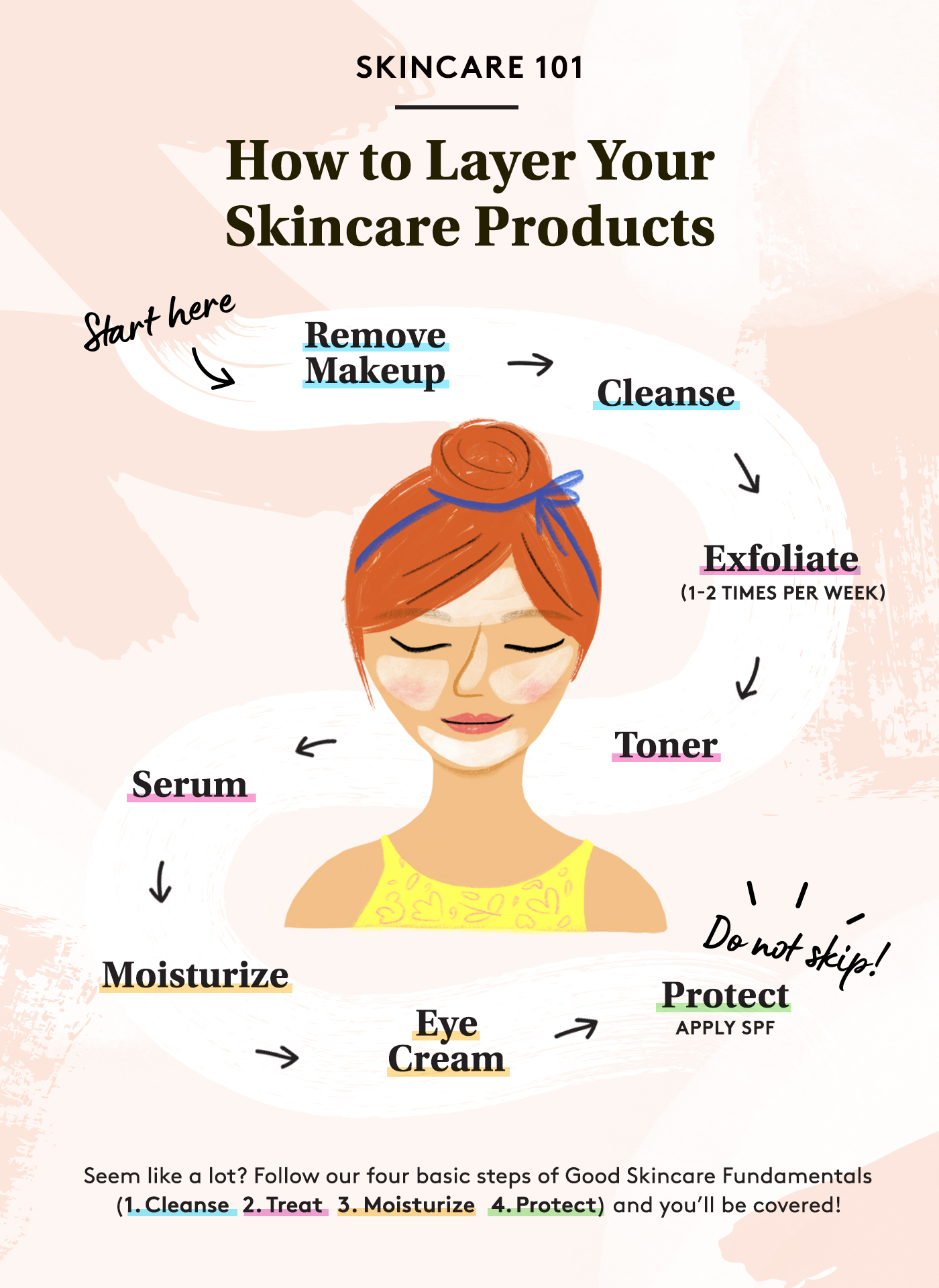
Diet vs skin condition
As much as sugary food is bad for your waistline, so is it for your skin! Acne and breakouts can be exacerbated by sugary foods.Sugar and foods high on the glycemic index (meaning foods that, once ingested, convert quickly into glucose and cause your body’s insulin levels to elevate) lead to a burst of inflammation that goes throughout your entire body (6).
Vitamin C
Vitamin C is a very common vitamin used to make skin become radiant and glow. Vitamin C-rich foods are often used to boost skin conditions. Fruits like guava are really rich with vitamin C; it even has twice the content of vitamin C in an orange!
However, if one is a picky eater, it is also best to actually consume a vitamin C supplement rather than apply it topically (topical application). On the market, there are many types of vitamin C supplements. Most of it has really high vitamin C content, such as 500 mg or 1000 mg. However, according to the RNI (recommended nutrient intake), our body only needs about 70 mg of vitamin C, so the higher dosage of the vitamin will just be excreted through urine.
On the supplement ingredients list, you can see whether the supplement is made from natural or synthetic ingredients.Synthetic vitamin C is called ascorbic acid; it usually irritates the stomach and has a higher dosage of vitamin C as compared to vitamin C that is derived from natural fruits like berries, guavas, oranges, etc.
Synthetic vitamin C or ascorbic acid is also usually coloured with food colouring to make the supplement look as if it has a high content of vitamin C. If you notice that your soluble vitamin C supplement stains your glass of water after being diluted in it, there is a high probability that the supplement that you are taking has food colouring in it.
So be wise in choosing your vitamin C supplements. In order to make your skin glow, know how to find good vitamin C. Remember, it has to be derived from a natural source with no coloring, and the content of the vitamin C does not need to be too high!
References
- Health (May, 15 2012). 15 Ways Smoking Ruins you Skin. https://www.health.com/condition/smoking/15-ways-smoking-ruins-your-looks
- Skin Cancer Foundation (June, 2019). All about Sunscreen, Why you need it and how it works for you?. https://www.skincancer.org/skin-cancer-prevention/sun-protection/sunscreen/
- WebMD (n.d). Exercise for Healthy Skin. https://www.webmd.com/skin-problems-and-treatments/acne/features/exercise#
- Healthline March, 2, 2018). Is My Skin Dehydrated? https://www.healthline.com/health/dehydrated-skin
- Kari Molvar. The New York Times (n.d). How to Build a Skincare Routine. https://www.nytimes.com/guides/tmagazine/skincare-routine
- Forbes (n.d). Does Eating Sugar really Caue Acne? https://www.forbes.com/sites/quora/2017/01/20/does-eating-sugar-really-cause-acne/#14aa38515af4
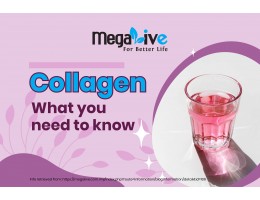
Collagen: What You Need to Know
The word collagen comes from the Greek word "kola,” which means glue, and that is basically the function of collagen, which is to hold protein and/or non-protein substances together. As an example, in the skin, the function of collagen is to hold all the skin structure together. Collagen is one of the major building blocks for many parts of the body, including bones, skin, tendons, and ligaments. It accounts for about one-third of the body's protein composition. It is also found in many other body parts, including blood vessels, corneas, and teeth.
Types of collagen
There are various types of collagen, but the main types are type I, type II, type III, and type IV.
Type I: Most of your body’s collagen is made of type I. It is a densely packed fibre that provides structure to skin, bones, tendons, fibrous cartilage, connective tissue, and teeth.
Type II: This type is made of more loosely packed fibres and is found in elastic cartilage, which cushions the joints.
Type III: This type supports the structure of muscles, organs, and arteries.
Type IV: This type helps with filtration and is found in the layers of your skin.
Collagen in Skin: Do We Need It?
Our body can produce its own collagen; however, the production of collagen gradually declined as we aged, which explains that among the signs of ageing are wrinkles, which come from skin that is less elastic, less supple, and unfirm.
Researchers also revealed that women lose collagen faster than men, causing women’s skin to age faster than men. Apart from gender, nutrition, and recreational drugs, environmental stress such as sun exposure, exposure to toxins such as pollutants, and cigarette smoke can also affect the level of collagen in the body.
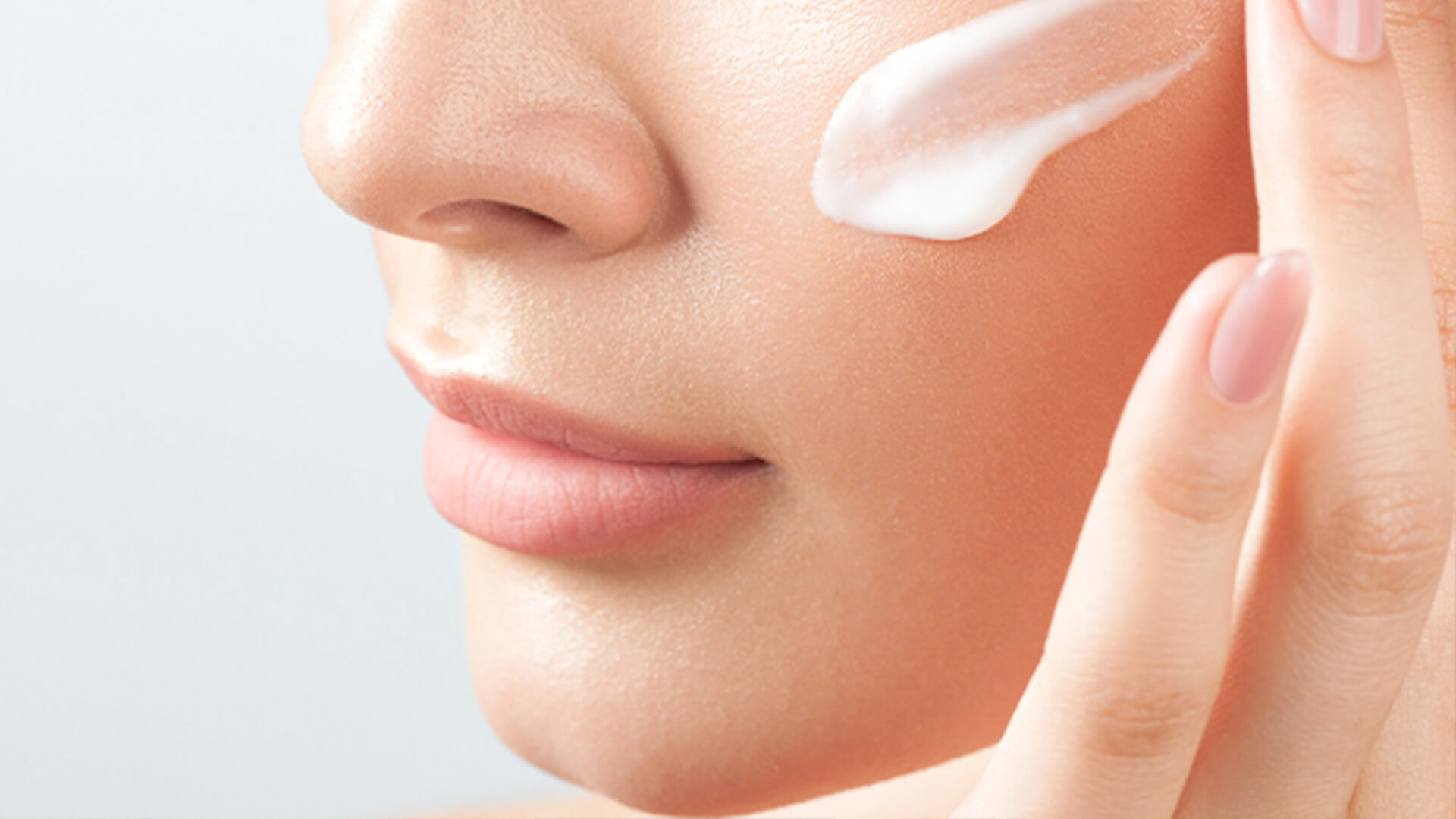
Where can we get collagen from?
The good news is that collagen can be gotten from food. There are foods that can stimulate the production of collagen and break down collagen. The body makes collagen by combining proline and glycine (types of proteins). Thus, consuming foods high in proline and glycine will help restore collagen levels in the body.
According to Dr. Bradley from the Cleveland Clinic, your body cannot make them if it doesn’t have them, which means all the nutrients, such as glycine and proline, are essential to produce collagen, but if we do not acquire them from our diet, then our body might not be able to produce collagen. Foods that are high in collagen are mostly derived from protein-rich foods such as bone broth, pork, chicken, beef, eggs, and fish. Plant-based foods also have added benefits to collagen-rich food consumption since vegetables and fruits contain high levels of antioxidants that can protect against reducing collagen. Types of foods that can break down collagen are sugary foods and refined carbs.
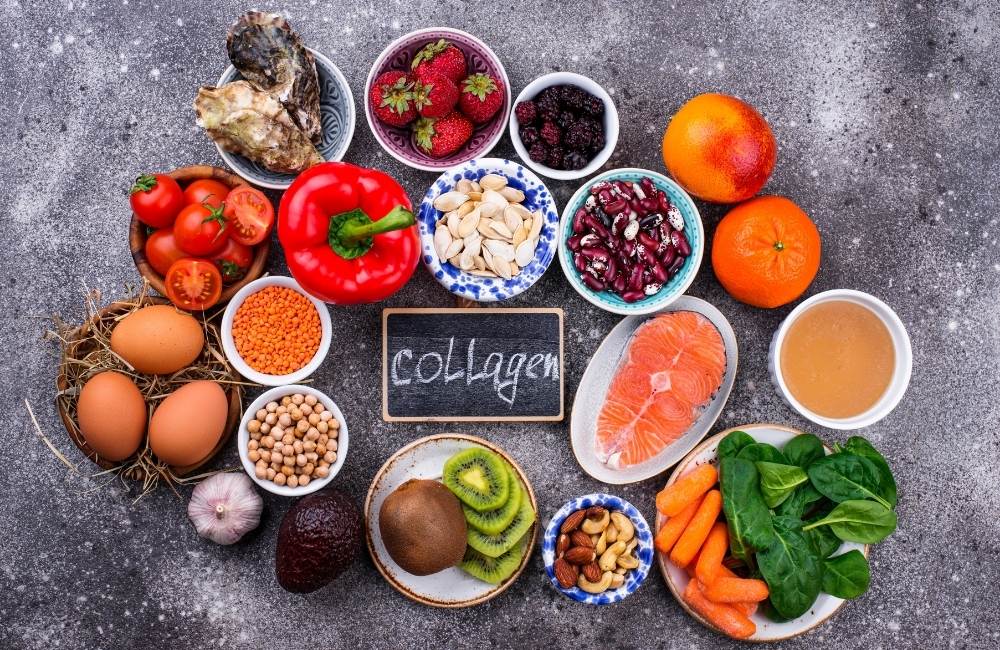
As for supplements containing collagen, they are usually in the form of hydrolyzed collagen. The source of hydrolyzed collagen can be fish, marine seaweed, pork skin, or other food sources that have high collagen contents. It is also said that hydrolyzed collagen is much easier to absorb by the body as compared to collagen from food.
To date, studies that report whether consumption of collagen has benefits to skin, joint health, muscle mass, bone, and many more are inconsistent. It depends on various factors such as the source of collagen, the bioavailability of collagen, the frequency of consuming it, the severity of a skin condition or joint condition previously, and many more. Thus, it is advisable for individuals to check the supplement ingredients prior to consuming any kind of supplement.
Individuals with cyst problems and cancer problems must be careful with their consumption of collagen supplements, as they can be harmful. Hence, it is best to seek professional help before consuming any supplement. Certain supplements are contraindicated with the medicine that you are consuming, etc.
References
- Top 6 Benefits of Taking Collagen Supplement. https://www.healthline.com/nutrition/collagen-benefits#_noHeaderPrefixedContent (Accessed on December 29, 2020)
- (n.d). Collagen, what is it and what it is good for? https://www.healthline.com/nutrition/collagen (Accessed on December 29, 2020).
- Atikah Khalim (2015). Ministry of Health Malaysia (MOH). My Health Portal. Collagen. http://www.myhealth.gov.my/en/collagen/
- Fadzilah kahar (2015). Ministry of Health Malaysia (MOH). My Health Portal Collagen and its source. http://www.myhealth.gov.my/kolagen-dan-sumbernya/
- Cleveland Clinic. The best way you can get more collagen. https://health.clevelandclinic.org/the-best-way-you-can-get-more-collagen/ (Accessed on December 29, 2020).
- What is collagen. https://www.livescience.com/collagen.html#:~:text=Collagen%20refers%20to%20a%20family,in%20the%20body%20by%20mass. (Accessed on December 29, 2020).

Foods that can MAKE or BREAK your skin!
Our skin is one of the largest organs in our bodies. It is our body's main defense organ against external insults such as radiation, ultraviolet rays, pathogenic microorganisms (bad bacteria), and mechanical and chemical stress (1). The condition of the skin or the skin barrier is greatly supported by the foods that we eat, whether we like it or not. There are foods that can benefit your skin and foods that can harm your skin. The foods listed below can either make or break your skin!
Omega-3-rich foods
The term "good fat" usually refers to omega-3 fatty acids. It regulates skin oil production, improves hydration balance, controls breakouts, and reduces signs of ageing. Furthermore, when applied topically, it can help soften rough, dry skin and soothe irritation and dermatitis. Omega-3-rich foods can improve skin composition by balancing its inflammatory response to sun damage, as well as improve sensitive skin condition by making it less dehydrated and dry.
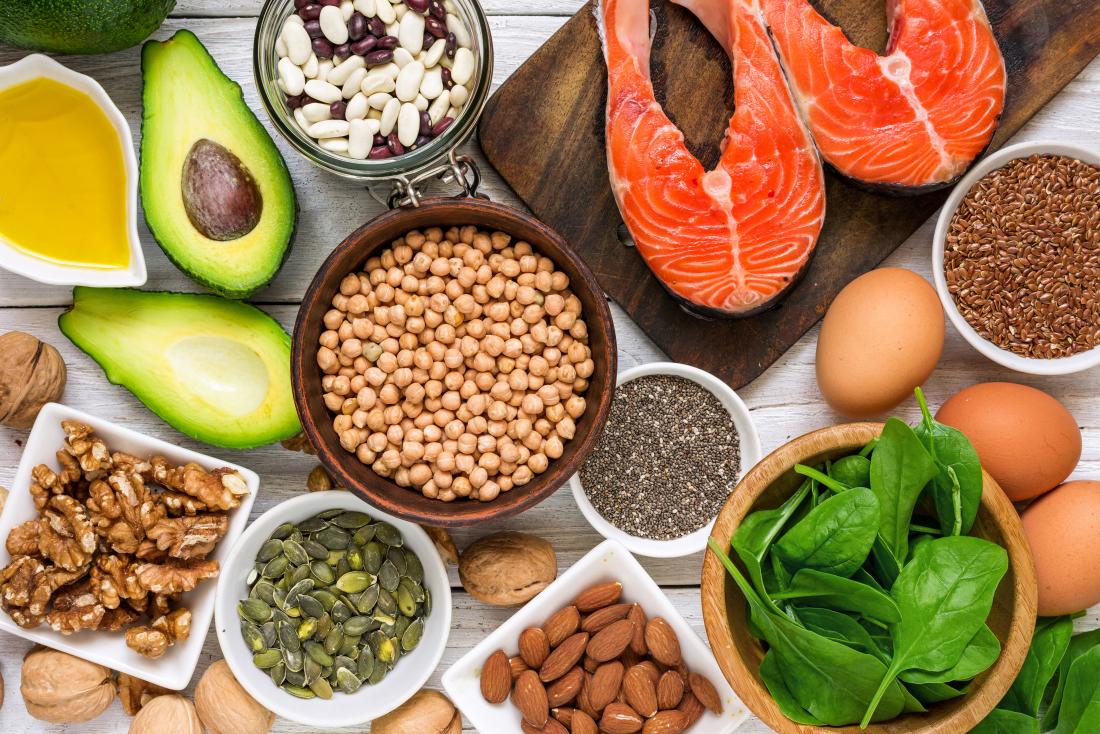
Fish is high in Omega 3 fatty acids. Specifically, fish oil. As a result, if an individual does not consume fish at all or prefers not to consume fish, it is recommended that they take Omega 3 and 6 supplements for their heart health. Omega-3-rich fish include mackerel, tuna, sardine and anchovies, salmon, and herring. Freshwater fish rich in omega 3 are also available in Malaysia, including catfish (ikan keli), patin fish, and terubok fish.
Aside from that, certain plant-based foods, such as spinach (bayam), mustard leaf (sawi), and 'salad roket,' contain high levels of omega 3. There are also omega-3-rich oils that can be used in cooking, such as canola oil. Also, if you want to improve the health of your skin, instead of snacking on chips or other unhealthy foods, try eating walnuts, which are high in omega 3.
Antioxidant and vitamin-rich foods
Plant-based foods, such as vegetables and fruits, are typically high in antioxidants and vitamins. Fruits and vegetables high in vitamins like C, E, and A are known as skin best friends.' All of these vitamins work in the same way when they engulf free radicals or reactive oxygen species (ROS). Free radicals can be produced naturally in the body, or as a result of UV radiation exposure, among other things. In other words, it is something that happens to everyone. As a result, it is critical to consume foods high in vitamins and antioxidants to combat all of the problems caused by free radical formation.
The Malaysian Ministry of Health recommends eating two servings of fruits and three servings of vegetables per day. The cupped hand size is used to determine vegetable serving size. As a result, 2 cupped hand size equals 2 servings. While the serving size for fruit varies depending on the type of fruit, 1 serving is equivalent to 1 fruit for medium-sized fruit such as apple, pear, and orange, while larger fruit is dependent on the normal cut sized. To simplify things, if you eat two apples, two pear, two bananas, or two oranges per day, you've already met the daily serving requirement.
Guava, orange, and lemon are examples of vitamin C-rich foods. Did you know that guava has twice the vitamin C content of an orange of the same size? Consuming 2 servings of guava or 1 small guava already meets your daily vitamin C requirement (75mg).
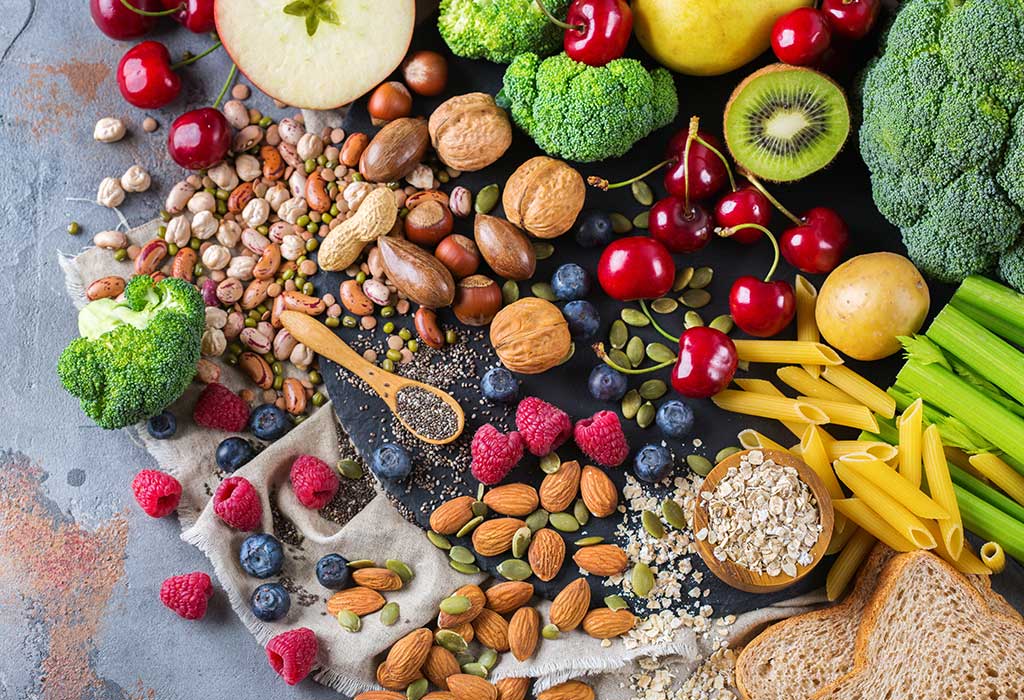
Almond, pumpkin, corn, collard, red bell pepper, and soy-based foods are examples of vitamin E-rich foods. According to research, Vitamin E or tocopherol works synergistically with Vitamin C to protect against UV radiation or sun damage.
Since most of the antioxidant- and vitamin-rich foods are mainly fruits and vegetables, it is essential to consume fruits and vegetables as suggested to have young looking skin!
Sugar
Sugar, as many people already know, is bad for your health because it raises your blood sugar level, which can lead to obesity, diabetes, heart disease, and other metabolic diseases. But it's also bad for your skin.
Sugar, in any form, has an impact on the two main causes of acne: hormones and inflammation. When you consume refined and processed carbohydrates, such as white sugar, your blood sugar levels rise faster, and your pancreas responds by releasing insulin. By avoiding sugar, you may be able to reduce the amount of insulin your body produces, which will reduce the oil and acne production.
Desserts such as cakes, tarts, cookies, 'traditional' kuih, and bakery products are high in sugar. Our daily staple foods are also high in refined carbohydrates or refined sugar. White rice, white bread, noodles, and flour-rich foods are all high in refined carbohydrates, which can harm the skin condition in the long run.
In conclusion, eating a healthy and well-balanced diet is the best way to achieve younger-looking skin. Consuming a lot of fresh products, limiting processed foods, oily foods containing trans fat, and sugary foods will help you not only have younger looking skin but also a healthier body!
References
- Cleveland Clinic. 23 Foods that are good to your skin. https://health.clevelandclinic.org/23-foods-good-skin/ (Accessed on January 8, 2020).
- Food fix: Healthier skin. https://www.healthline.com/health/beauty-skin-care/skin-diet#Food-Fix:-Foods-for-Healthier-Skin (Accessed on January 8, 2020).
- Dattola, A., Silvestri, M., Bennardo, L., Passante, M., Scali, E., Patruno, C., & Nisticò, S. P. (2020). Role of Vitamins in Skin Health: A Systematic Review. Current Nutrition Reports, 1-10.
- Schagen, S. K., Zampeli, V. A., Makrantonaki, E., & Zouboulis, C. C. (2012). Discovering the link between nutrition and skin aging. Dermato-endocrinology, 4(3), 298-307.
- Cao, C., Xiao, Z., Wu, Y., & Ge, C. (2020). Diet and Skin Aging—From the Perspective of Food Nutrition. Nutrients, 12(3), 870.
- Siong, T. E., ASEAN, K. L. M., Noor, M. I., Azudin, M. N., & Idris, K. (1988). Nutrient composition of Malaysian foods.
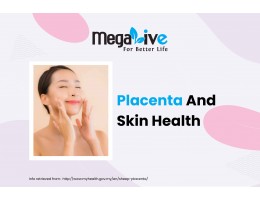
Placenta and skin health
The placenta is an organ that connects the foetus to the mother. It transfers oxygen and nutrients to the foetus and removes foetal waste products to the mother. When the baby is born, the placenta will also be discharged from the mother’s body. There has been a growing interest in placenta extraction as it is said to have high nutritional value. The nutritional substance includes cytokines, hormones, bioactive peptides, enzymes, growth factors, vitamins, and minerals.
Culturally, humans rarely consume placenta, but recently there has been growing interest in consuming placenta, be it from humans or animals. Mammals have been consuming placenta since years ago; it is called placentophagia, while in humans it is called placentophagy. The placenta could be served raw, cooked, or encapsulated and taken as a supplement as it contains various nutritional benefits.
Rave on this started when many Hollywood celebrities started using placenta therapy as part of their skincare routine treatment. Celebrities like Kim Kardashian, Victoria Beckham, and even male celebrities like Harry Styles from One Direction have said they have been using this for their skin to get baby-soft skin.
Placenta consumption in Malaysia.
In Malaysia, it is rare for people to consume raw placenta. Usually, it comes in health supplement form and is derived from deer or sheep. Hence, as it is in health supplement form, any products containing placenta extract in a pharmaceutical dosage will require to be registered with the Drug Control Authority (DCA) before they are sold or used in Malaysia.

Benefits of placenta consumption.
Findings from research reported that nutrients that are delivered via the placenta could be retained even after the process of delivering the baby. The research also stated that the placenta contains collagen, elastin, laminin, and vitamins such as B1, B2, B3, B4, B5, B6, B7, and B12. All these vitamins, better known as B complex vitamins, play roles in cell metabolism, cell division, cell development, and energy production.
Due to this aspect as well, it is said that it gives a lot of benefits to skin health. Placenta is even used in clinical settings, such as for burn injuries and wound healing. In one study, researchers compared the efficacy of topical placental extract dressings versus povidone iodine dressings in diabetic wounds in a variety of patients. Placenta wound dressings could significantly accelerate the rate of wound healing when compared to povidone-iodine dressings as they contained amino acids, vitamins, and nucleotides, which accelerated wound healing recovery by seven to ten days.
Due to all these effects, many skincare products have recently incorporated placenta, be it from sheep or deer, in their skincare or supplement products.
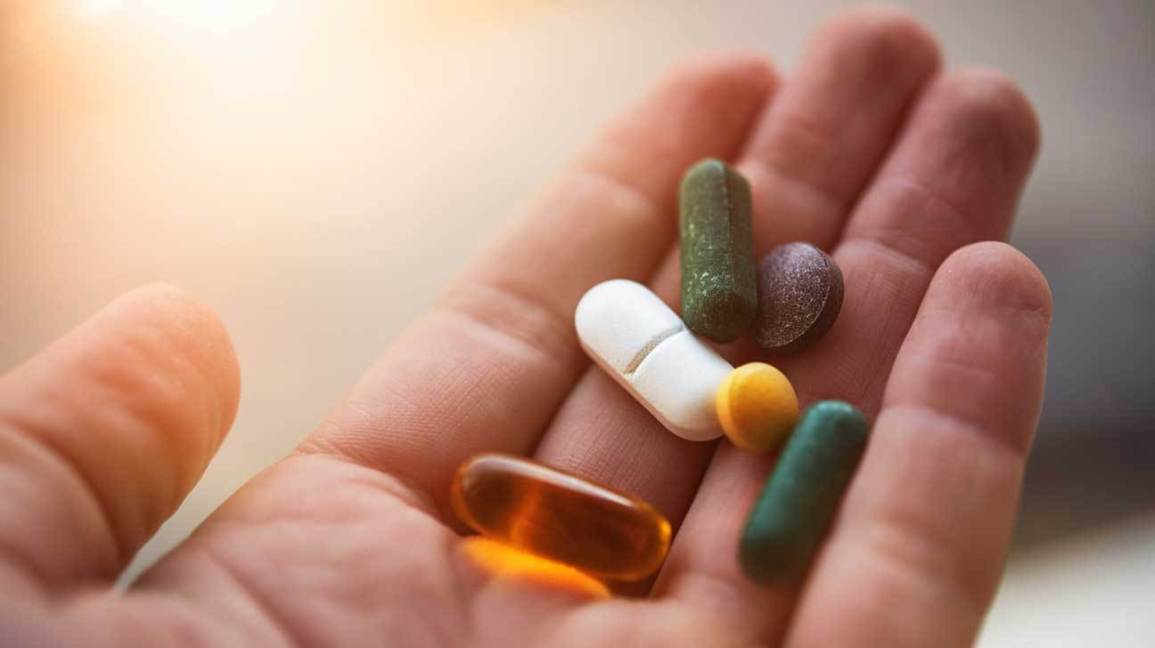
Caution with regard to placenta in the supplement
When it comes to placenta consumption as a health supplement, it is evaluated based on its safety of use and product quality. To be safe, sheep placenta products must be hormone-free. Because placenta typically contains hormones such as testosterone, oestrogen, and progesterone, being hormone-free is much more important for a placenta-based supplement. To confirm whether the products you are considering or consuming have been notified by the Ministry of Health, you can conduct an online product search on the National Pharmaceutical Registration Agency (NPRA). However, if the product is not listed in the DCA, it is not recommended that you consume it because its safety and quality have not been evaluated, and it may pose a health risk.
References
- Ministry of Health (MOH). MyHealth Portal. Sheep Placenta. http://www.myhealth.gov.my/en/sheep-placenta/ (Accessed on January 13, 2021)
- Pan, S. Y., Chan, M. K., Wong, M. B., Klokol, D., & Chernykh, V. (2017). Placental Therapy: An insight to their biological and therapeutic properties. blood, 4(11), 12.
-260x200.jpg)
Does Having Younger Looking Skin Have Anything To Do With Foods Or Genetics?
But, what if it is not in good condition? Is it hormonal in nature? Is it related to food? Is it hereditary? Is it any of these?
Yes, it is indeed all of these!
Skin that appears younger is closely related to lifestyle and genetics. According to research, there is a gene in the human body that controls our skin condition. Have you ever wondered why certain people of similar age but different appearances appear younger than their actual age while others appear older? The study by dermatologist professor Alexa B. Kimball from Harvard revealed that this has something to do with gene expressions.
According to the study, people with rapid gene expression speed up the skin-repairing process when exposed to external or internal stress, which is why they can maintain younger-looking skin. It has also been observed that some people who appear young have rapid gene expression that mimics those who are younger than their chronological age. According to the professor, the skin appears younger because it behaved younger (1)!
To elaborate, the one described above is known as intrinsic skin ageing, and it represents chronological ageing, with the same pattern affecting all internal organs. Extrinsic skin ageing, also known as aged skin, is caused by external factors such as environmental influence, particularly chronic sun exposure and ultraviolet (UV) irradiation, but also smoking, pollution, sleep deprivation, and poor nutrition. As a result, when it comes to skin, the best way to avoid harm is to avoid all of these extrinsic factors (1).
A study that compared sun-exposed skin (face and forearm) to sun-protected skin (buttock) among women aged 20 to 70 years old discovered that ultraviolet (UV) exposure is a major driver and accelerator of skin ageing. Although sun exposure without any skin protection, such as sunscreen, is harmful to the skin, there is a recommended amount of time spent outdoors without sunscreen so that UVB from the sun can activate vitamin D3 in the skin. The recommended exposure time is 5 - 30 minutes between 10 a.m. and 3 p.m., at least twice a week, to the face, arms, legs, or back (2). In Malaysia, where the weather is sunny all year, excessive sun exposure can cause skin damage. As a result, if one of your 2021 resolutions is to avoid sun damage, you should start wearing sunscreen religiously!
Apart from smoking and pollution, which can both cause skin damage, sleep deprivation can also cause skin to appear older. Sleep serves as a reset button for our entire health, including our skin. During sleep, the blood flow to the skin increases, and the organ rebuilds collagen and repairs UV damage, reducing wrinkles and age spots. According to research, sleep deprivation affects wound healing, collagen growth, skin hydration, and skin texture. Inflammation is also higher in sleep-deprived individuals, causing acne outbreaks, eczema, psoriasis, and sin allergies. To combat this, health experts recommend 7 to 9 hours of beauty sleep per day to achieve fluffy baby skin (3,4)!
Poor nutrition is also a major contributor to the appearance of older skin, and the worst culprit of all is sugar! Glycation is the process by which sugar interacts with skin. Younger-looking skin is always associated with firm and elastic skin, which refers to the cross-linking structure of skin fibres. This structure can repair itself naturally; however, when sugar is consumed, the glycation process renders the structure and renders the skin unable to remodel into its original structure. As a result, the youthful skin condition has vanished! This explain, sugar consumption is not only bad for metabolic conditions like diabetes mellitus, but also for skin conditions.
To summarise, the skin is the largest and most delicate organ; it may appear strong and capable of withstanding all of the external and internal harm that we inflict on it, but it, too, requires pampering. A good skincare routine will help with its condition, but it also requires good food, hydration, and sleep to keep everything in check and balance!
References
- Beth Israel Deaconess Medical Center. (2017, November 28). Expression of certain genes may be key to more youthful looking skin: Certain gene expression patterns identified in women who appear younger than their chronologic age. ScienceDaily. Retrieved January 18, 2021 from sciencedaily.com/releases/2017/11/171128102918.htm
- Ministry of Health Malaysia (MOH). MyHealth Portal. Vitamin D and sunlight. http://www.myhealth.gov.my/en/vitamin-d-and-sunlight-2/
- Kahan V, Andersen ML, Tomimori J, Tufik S. Can poor sleep affect skin integrity? Med Hypotheses. 2010 Dec;75(6):535-7. doi: 10.1016/j.mehy.2010.07.018. Epub 2010 Aug 1. PMID: 20678867.
- 6 Ways to Maximize Your Beauty Sleep for #wokeuplikethis skin. https://www.healthline.com/health/beauty-skin-care/beauty-sleep (Accessed on January 19, 2021).
- Danby, F. W. (2010). Nutrition and aging skin: sugar and glycation. Clinics in dermatology, 28(4), 409-411.
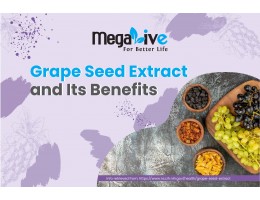
Grapeseed Extract and its benefits.
Numerous studies have shown that grape seed extract contains a high level of antioxidants. Using punctured wounded mice, researchers discovered that mice treated with GSE in the wound affected area grew tissue faster than mice treated with only normal saline. Another difference between GSE-treated mice and placebo-treated mice was more organized tissue formation and a higher rate of collagen deposition.
Topical application of 2% GSE cream in the area of a post-surgery surgical wound heals the wound completely in an average of 8 days, compared to 14 days for placebo. This is due to GSE's vascular endothelial growth factor (VEGF) properties, which promote the regeneration of damaged blood vessels while increasing the amount of free radicals present at the wound site. Free radicals aid in the killing and removal of pathogenic bacteria and endotoxin from the site, as well as in the healing of wounds.
Apart from wound healing and skin health properties, it also has anti-ageing properties. GSE proanthocyanidins delay skin ageing by reducing lipid oxidation on the skin structure.
Cardiovascular and antihypertensive properties.
Cardiovascular disorders (CVD) are among the major problems that arise due to modern, unhealthy lifestyles, which are the primary cause of death worldwide. It is a disorder that affects the condition and function of the heart and blood vessels in general. Changes in these two can result in cardiac arrest, heart stroke, hypertension, chest pain, and other complications. Studies show that GSE may prevent atherosclerosis (a condition where there is a build-up of fats, cholesterol, etc. in the blood vessel walls, which can restrict blood flow), inhibit or limit the oxidation of LDL (bad cholesterol), reduce inflammation, inhibit platelet aggregation, and lower blood pressure. It lowers blood pressure by suppressing oxidative stress and inhibiting the angiotensin-converting enzyme (ACE) and nitric oxide, which mediate vasodilation, hence making the constricted blood vessels dilate and improving blood pressure.
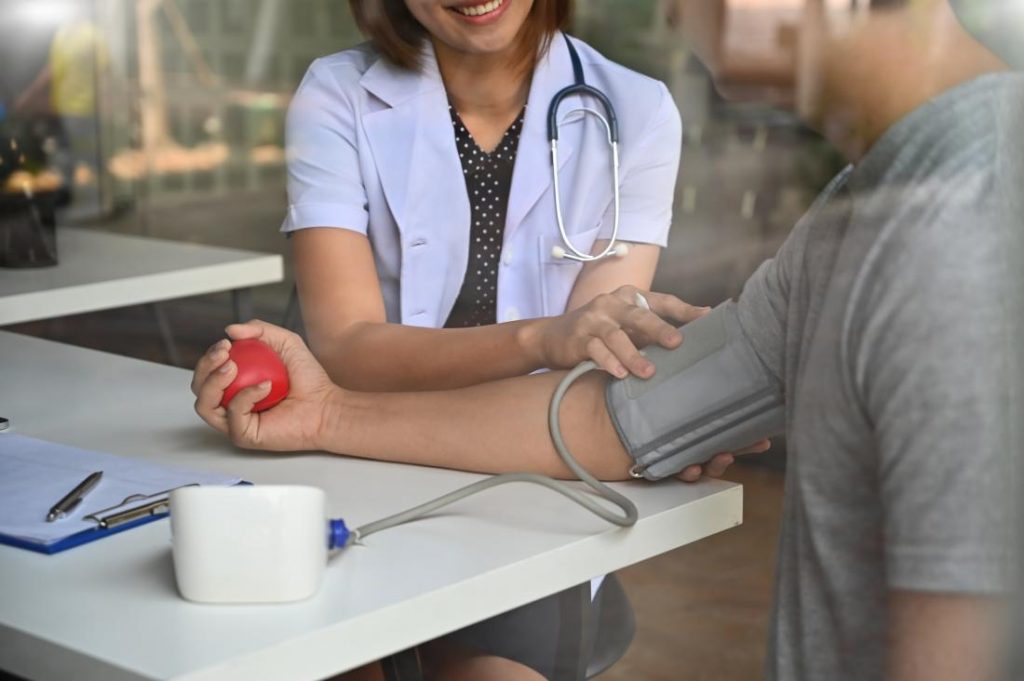
Antimicrobial activity
GSE has been shown to have antimicrobial properties; for example, when applied topically, resveratrol in GSE increases the production of cathelicidin, which inhibits the growth of Staphylococcus aureus. In another study, quercetin, caffeic acid, and quercetin-3-0-rutinoside in GSE were responsible for the inhibition of Listeria monocytogenes. It is also worth noting that GSE had the highest inhibition activity against almost all Listeria species. The review on the benefits of GSE also reported that the antimicrobial effect of GSE is attributed to changes in cell morphology and DNA content.
Cosmetic and nutraceuticals
Skin ageing is a natural process which occurs due to the external and internal factors involving genetic, hormonal, and environmental factors. GSE is rich in proanthocyanidin help to reduces the lipid oxidation of cellular structure of the skin and inhibit the production of free radicals. A study was carried out in which the anti-ageing effect of GSE was investigate. The study concluded that GSE has a promising role as an anti-ageing compound.
GSE help skin structure by strengthening the collagen-based tissue (by increasing the collagen cross links). It also increases the synthesis of collagen and the conversion of collagen from soluble into insoluble one.
In conclusions,
GSE has various benefits to health due to its high antioxidant properties, it is able to scavenge the free radicals which an essential feature that could help with various body functions.
References
- National Institute of Health (NIH). National Centre for Complementary and Integrative Health (NICCH). Grape Seed Extract. https://www.nccih.nih.gov/health/grape-seed-extract (Accessed on March 15, 2021).
- 10 Benefits of Grape Seed Extract, Based on Science. https://www.healthline.com/nutrition/grape-seed-extract-benefits (Accessed on March 15, 2021).
- Gupta, M., Dey, S., Marbaniang, D., Pal, P., Ray, S., & Mazumder, B. (2020). Grape seed extract: Having a potential health benefit. Journal of food science and technology, 57(4), 1205-1215.
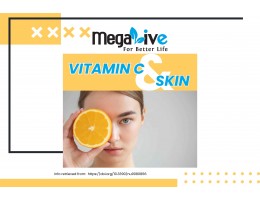
Vitamin C and Skin
Vitamin C can be said to be the most popular micronutrient of all. It serves various functions, from immune health to skin health. As of late, many skin care products have incorporated vitamin C as one of the ingredients, or it stands alone in skincare products. Many studies found that topical application of vitamin C showed positive skin changes in improving skin complexion, improving skin hydration, fading out hyperpigmentation, and reducing the appearance of under-eye circles.
But, according to the study, there are various hindrances to the absorption of vitamin C applied topically, such as skin pH, penetration of vitamin C into skin layers, oxidation due to exposure to harsh environments before the skincare is even applied to the skin, and many more.
Which is why people started to dig? What about the consumption of vitamin C? Will it help with skin health even better?
A study on the roles of vitamin C in skin found that the consumption of vitamin C helps with skin health via various pathways.
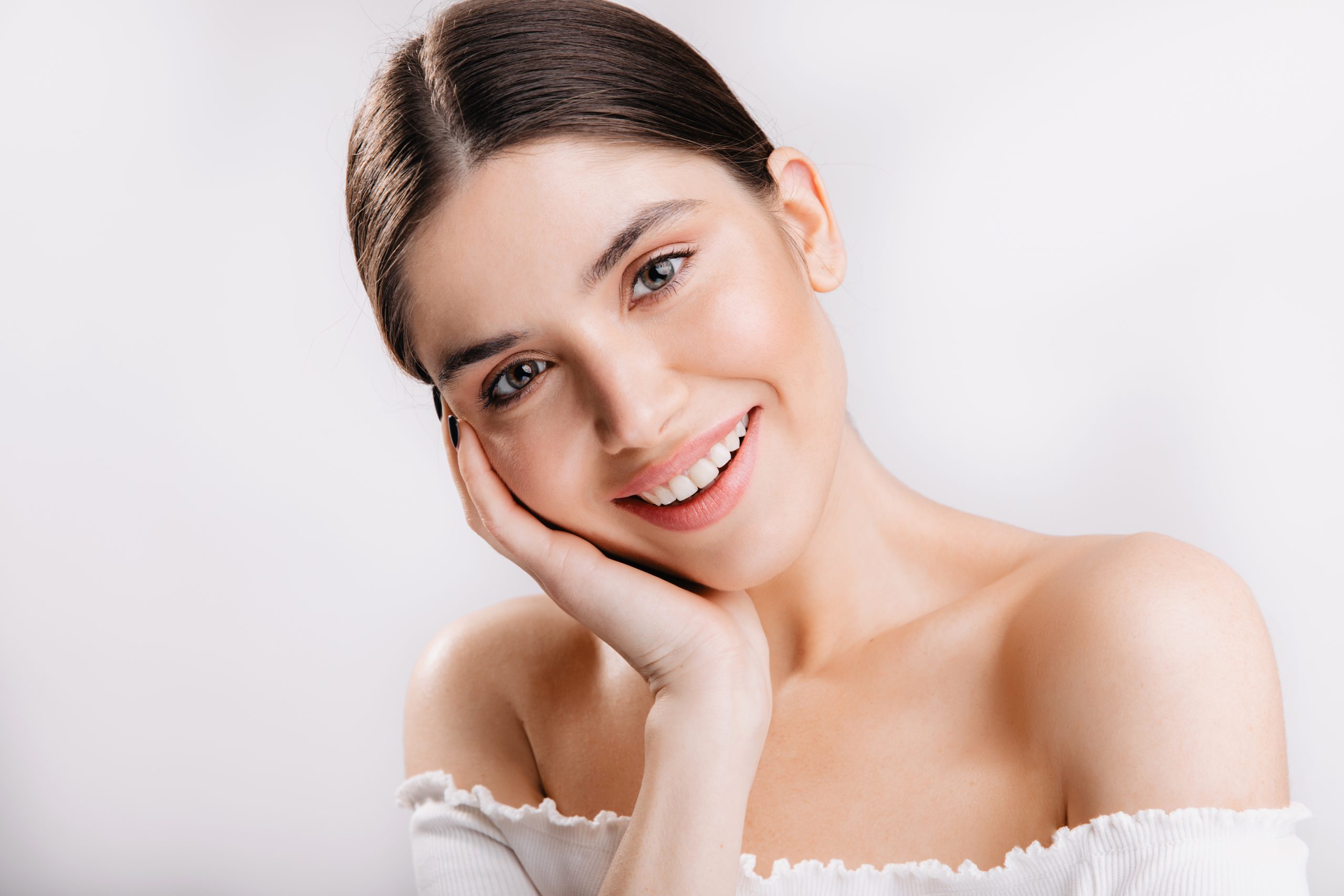
-
The promotion of collagen formation
Vitamin C acts as a co-factor for the proline and lysine hydroxylase enzymes that stabilise the collagen structure in skin. In the skin, collagen formation is carried out mostly in the dermis; it requires the enzyme lysine hydroxylase to form collagen, which is dependent on vitamin C. Which is why consumption of a sufficient amount of vitamin C helps with intact-looking skin due to the formation of collagen.
-
The ability to scavenge free radicals and dispose of toxic oxidants
Another important role of vitamin C is that it acts as a potent antioxidant, which can neutralise and remove oxidants from environmental pollutants and after exposure to ultraviolet (UV) radiation. But most intervention studies are carried out to see the effect or prevention of the damage using a cocktail of other ingredients as well (such as glutathione and vitamin E). Which is why it is said that vitamin C is particularly effective when it is used in conjunction with vitamin E.
-
Inhibition of melanogenesis
Vitamin C and its derivates, including the weak one (magnesium phosphate ascorbyl derivatives), have been shown to treat skin hyperpigmentation in conditions such as melisma, better known as age spots. This is due to the fact that it has been shown that it reduces melanin synthesis in the skin by interfering with the action of tyrosinase (the rate-limiting enzyme in the production of melanin).
These are all pathways through which vitamin C could help with skin health. During the course of life, the skin is exposed to various challenges that affect its structure, function, and appearance, including:
-
Ageing: loss of elasticity and wrinkle formation
-
Exposure to elements leading to discoloration, dryness, and accelerated wrinkles.
-
Chemical insults such as soaps, hair dyes, and detergents
-
Direct injury, such as wounding or bleeding.
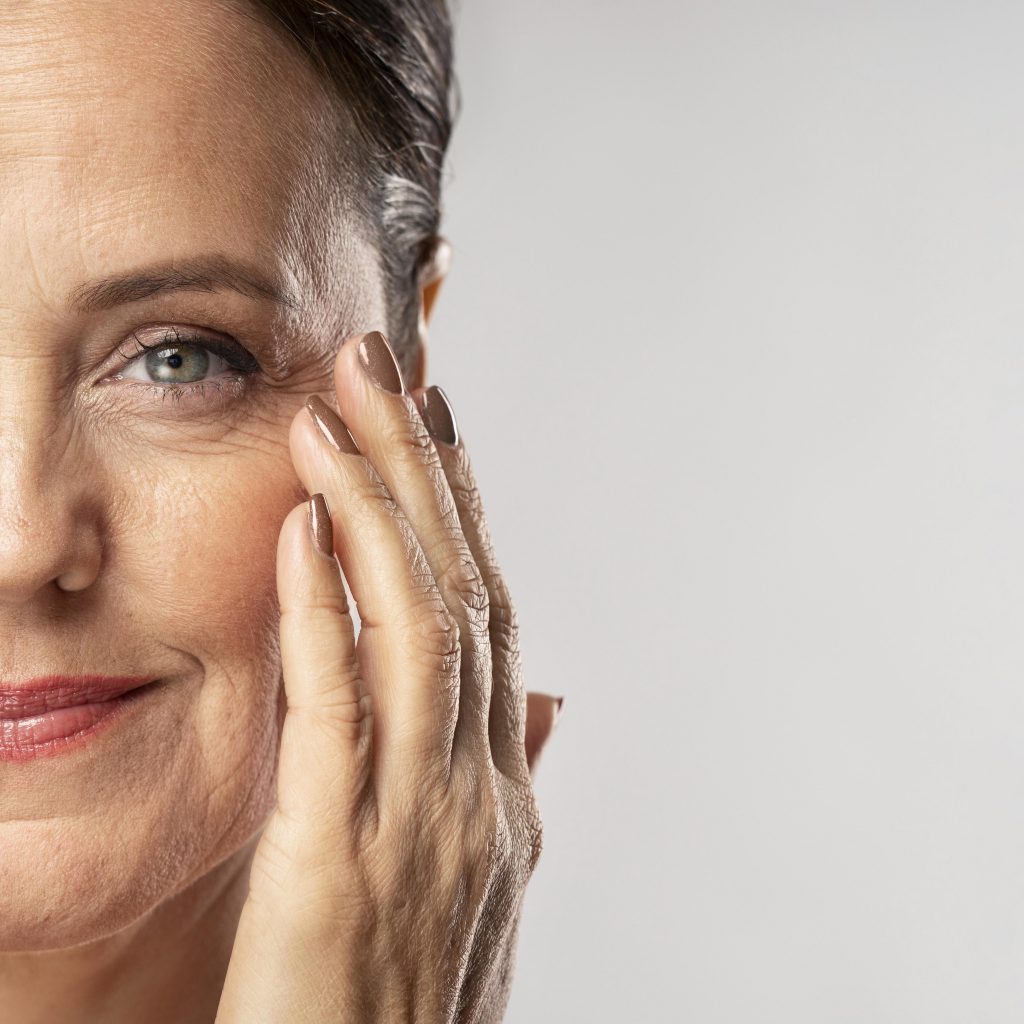
With all the factors from internal and external being addressed, it is thought that it can make things clear that the consumption of vitamin C is able to help with the prevention of further skin damage but at the same time must limit or reduce external factors that cause harm to skin; after all, prevention is better than cure, right?
Apart from this, 16 studies that investigate the consumption of vitamin C supplements or foods show that it improves skin appearance by improving skin elasticity, facial wrinkling, roughness, and discoloration.
Another double-blind nutrition intervention using cocktails of supplementation such as that high in antioxidants such as 10mg trans resveratrol, 60 mcg selenium, 10 mg vitamin E, and 50 mg vitamin C in papaya extraction among populations between 40 and 65 years old shows improved skin surface, brown spots, evenness, moisture, and elasticity after 90 days of supplementation.
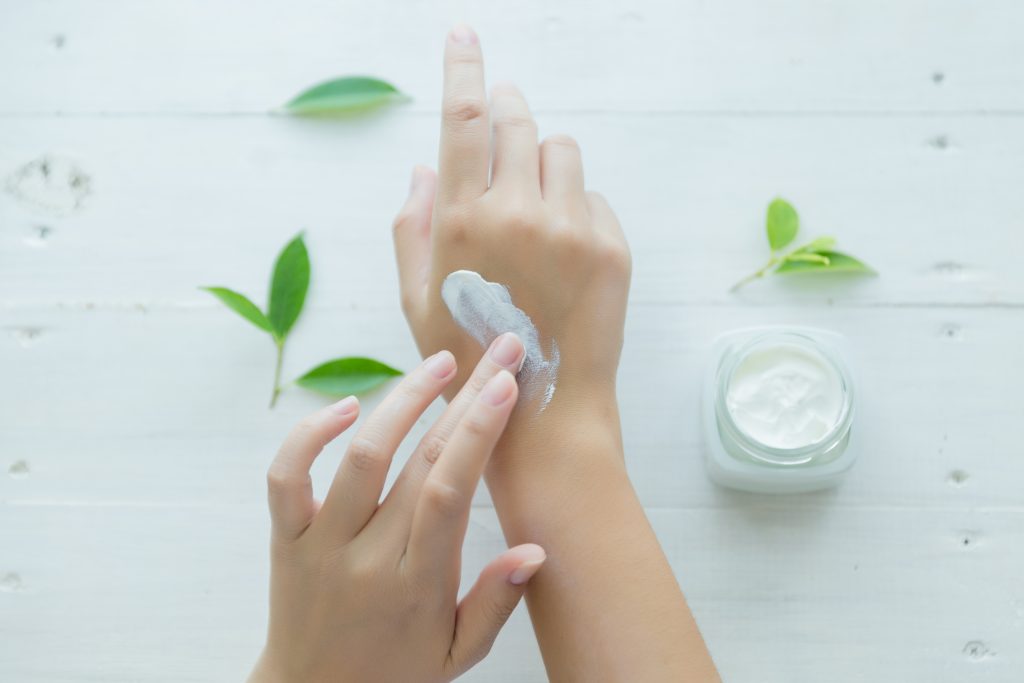
Based on all these data, the study stated that the efficacy of consumption of vitamin C is better at improving skin health as compared to topical application only. As the efficacy of topical application is based on the prior skin condition. In one study, it was suggested that when the health status is already optimal, meaning there is enough vitamin C, the topical application of vitamin C will not be absorbed into the skin. Hence, ‘beauty from the inside" via nutrition may be more effective than topical application.
References
-
Pullar, J. M., Carr, A. C., & Vissers, M. (2017). The Roles of Vitamin C in Skin Health. Nutrients, 9(8), 866. https://doi.org/10.3390/nu9080866.
-
Radiance by WebMD. Benefits of Vitamin For Your Skin Health. https://www.webmd.com/beauty/ss/slideshow-benefits-of-vitamin-c-for-skin (Retrieved on May 3rd, 2021).
-
11 Reasons to add vitamin C serum to your skincare routine. https://www.healthline.com/health/beauty-skin-care/vitamin-c-serum-benefits#how-to-use (Retrieved on May 3rd, 2021).
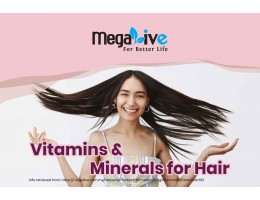
Vitamins and Minerals for Hair
There are many factors influencing the number of hair falls, from disease-related symptoms to simply nutrient deficiency. Some commonly heard causes of hair falls are alopecia, thyroid problems, and lupus. Which is why it is important to know how much hair falls are normal and when you should go and seek treatment.
According to the American Academy of Dermatology, common hair falls per day are about 50 to 100 strands of hair, as we have more than about 100 000 hair follicles on the head alone. Thus, losing about 50 to 100 strands of hair per day will not cause you baldness, patchiness, or spots, but of course, if you have longer hair, losing hair is more noticeable as compared to if you have shorter hair. Also, the formation of spots, patchiness, baldness in your hair area, and the pattern of clumps of hair loss are signs that you need to seek the advice of a primary care doctor or dermatologist.

Generally, according to scientists, it is hard to quantify the normal number of hair losses since it still depends on gender, the way hair is styled, the frequency of hair styling, the frequency of hair colouring, washing, bleaching, brushing, and heat styling. It is also noted that women tend to lose more hair than men, as 40% of women style their hair a lot more than men, and because women experience certain life events that make them lose more hair, such as during pregnancy, postpartum, and menopause.
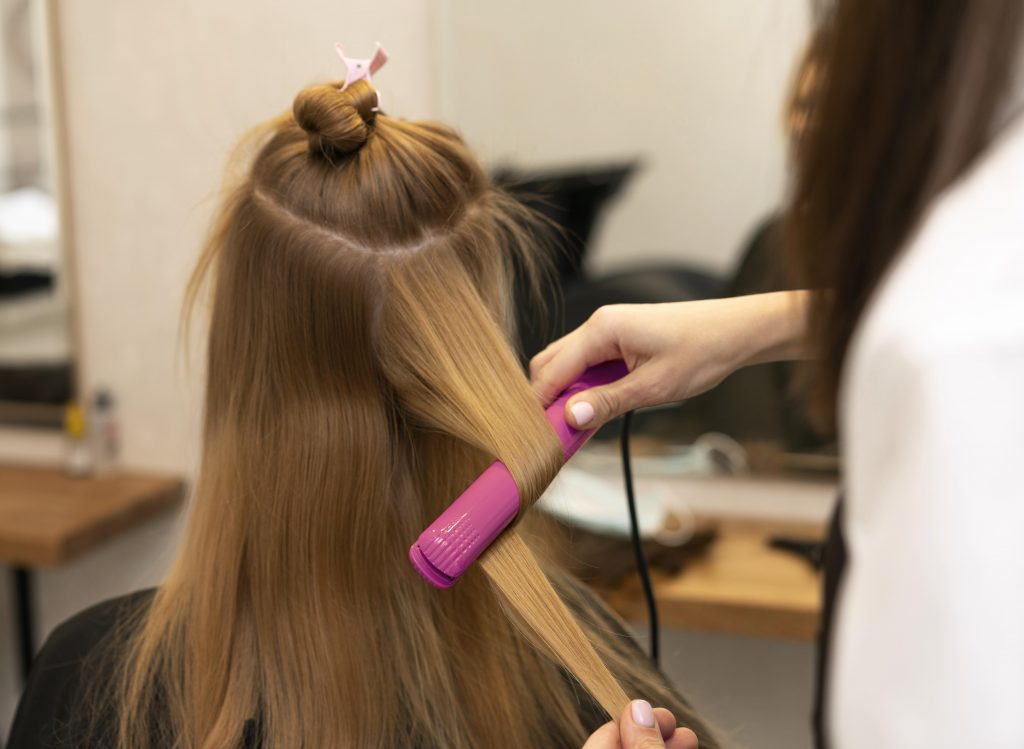
But if you are experiencing more hair loss than usual and it is not something due to diseases or life events that makes you stressed, you might need to find a solution to make your hair grow healthier again!
The answer to this is to improve your diet!
According to studies, minerals and micronutrients such as biotin are responsible for keratin production, which will help with hair growth. Vitamin C acts as a strong antioxidant to scavenge free radicals in hair follicles, resulting in strong hair roots. It also helps to produce collagen, which strengthens and prevents hair from becoming brittle and breaking. Vitamin C also helps to absorb more iron into the body, which can prevent anaemia, which can lead to more hair loss.
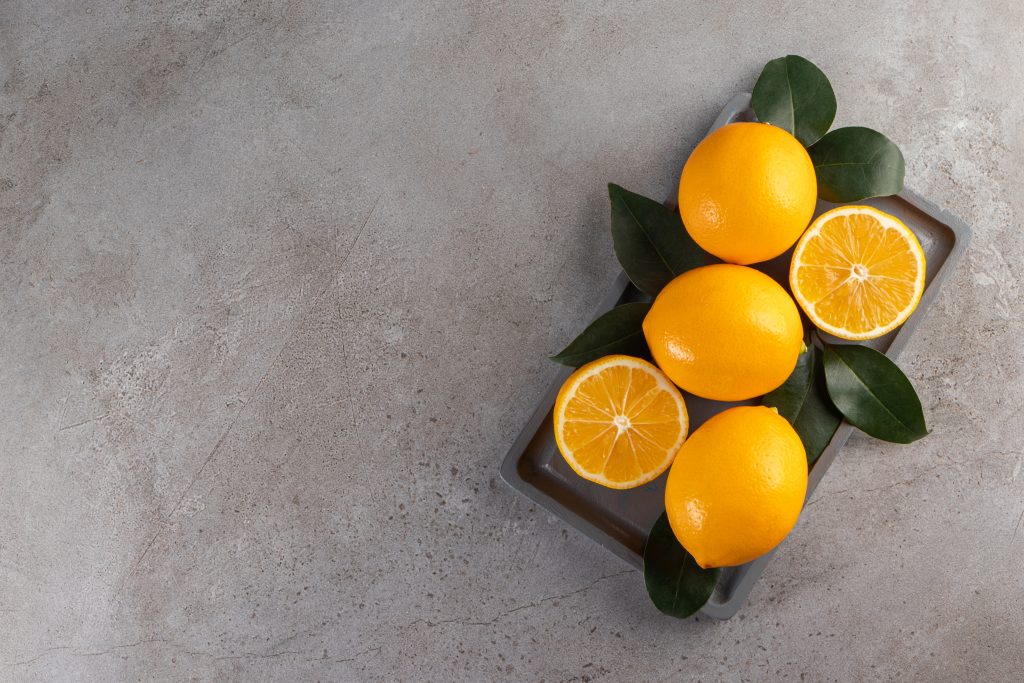
Another important nutrient is vitamin A. Vitamin A is abundant in yellowish-orange foods, such as carrots, but it is also present in greenish foods, such as spinach. It helps skin glands produce sebum, which will make hair less frizzy, brittle, and easily broken. Although vitamin A can improve your hair condition, too much vitamin A might be dangerous to your body and harm your hair! So, consume vitamin-rich foods moderately.
Zinc is a mineral that is essential for hair growth and repair. It also helps to keep the oil glands around the follicles working properly. Zinc-rich foods such as oysters, spinach, beef, and meat help reduce hair loss caused by zinc deficiencies.
In conclusion, identifying the type of nutrient that is beneficial for your hair health might give you an idea of what you can improve on and what you are lacking in your diet. In an effort to improve hair health, a hair care routine, such as washing hair when needed, avoiding heat styling and excessive hair styling, and avoiding exposure of hair to colourants, chemicals, etc. that can harm the hair for some time, can help improve its condition.

Collagen and it benefits to hair, skin, and nails.
Collagen is a type of protein that is necessary for formation of skin, nails, hair, cartilage, bones, teeth, and joint. It is in most of the organs in the body. It is the tissue that holds ligaments, joints, and bones together. Some collagen acts as a protective layer for organs in the body, such as the kidneys.
As we age, the production of collagen in the body decreases, it causes skin to become wrinkled. For certain people, even when they are still young due to exposure of skin to various harsh environments and conditions both internally and externally, collagen level in skin tend to diminish even quickly.
Collagen and skin
Collagen is the central element in the dermis layer (one of the skin layer), it comprises about 70%-80% of skin. Whenever skin is wounded, collagen helps in wound healing through providing an ideal environment for cells to proliferate, which will help with the healing process. It also plays a significant role in all phases of wound healing, including haemostasis, inflammation, proliferation, and remodelling.
Studies shows that application of collagen in wounded skin is very beneficial since the collagen is highly porous and have interconnected pore structure. It is said that collagen is beneficial to wound healing to the extent of, there is study noted that collagen potentially can be used for skin substitute in full thickness wound healing.
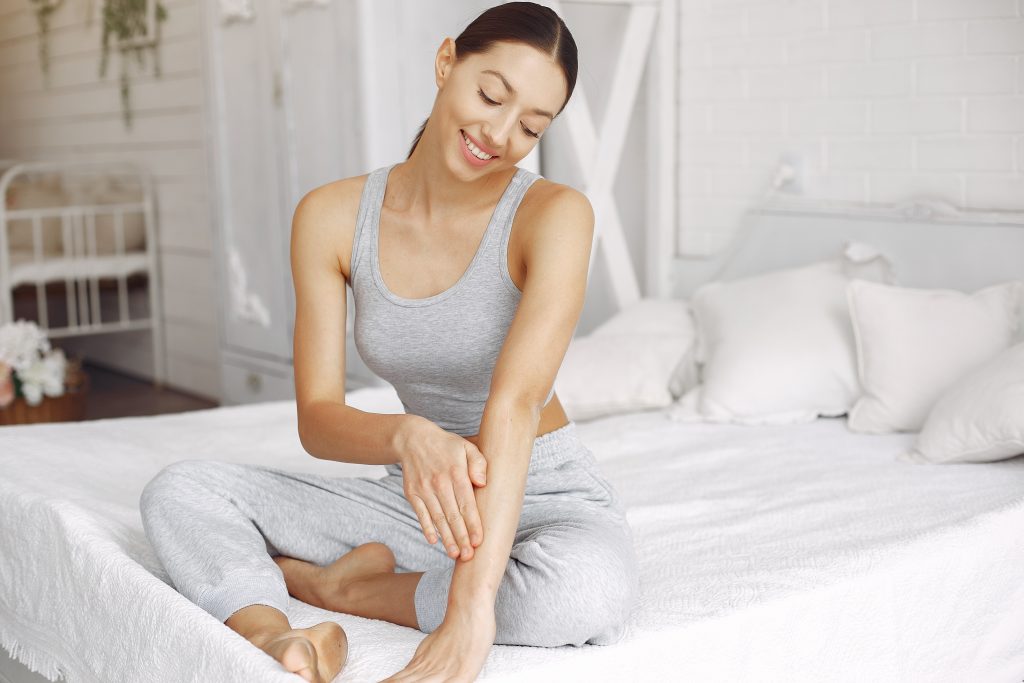
Collagen and hair
Building block of hair is protein keratin, by consuming collagen rich food and/or collagen supplement, it will then be break down into variety types of amino acids compound.
There are 11 types of non- essential amino acids, which body can produce itself, and there are 9 types of essential amino acids which need to be consumed from diet since body cannot produced it. Collagen is made up from three types of essential amino acids, which is why it is best to consume collagen, collagen rich foods, or variety of protein rich foods, so you may get different types of amino acids compound especially the essential amino acids compound which body cannot synthesized, so that we can improve level of collagen in the body.
Collagen helps to fight damage to hair follicles by functioning as antioxidants which helps to fight free radical. Free radical could develop due to stress, smoking, dietary habits and many more. These are all factors that we are at risk of everyday, by consuming collagen it helps to reduce damage in the hair follicles thus lead to a healthier hair growth. It may also help to prevent thinning due to ageing and slow down the appearance of greying.

Collagen and nails
A study that was conducted among men and women who experience brittle nail syndrome, where their nail exhibits rough surface, raggedness, and peeling, noted that consumption of collagen promoted an increase of 12% nail growth rate and a decrease of 42% in the frequency of broken nails. Additionally, 64% of participants experienced an improvement 4-week post treatment. Most participants (80%) agreed that the use of collagen help with their brittle nail syndrome.
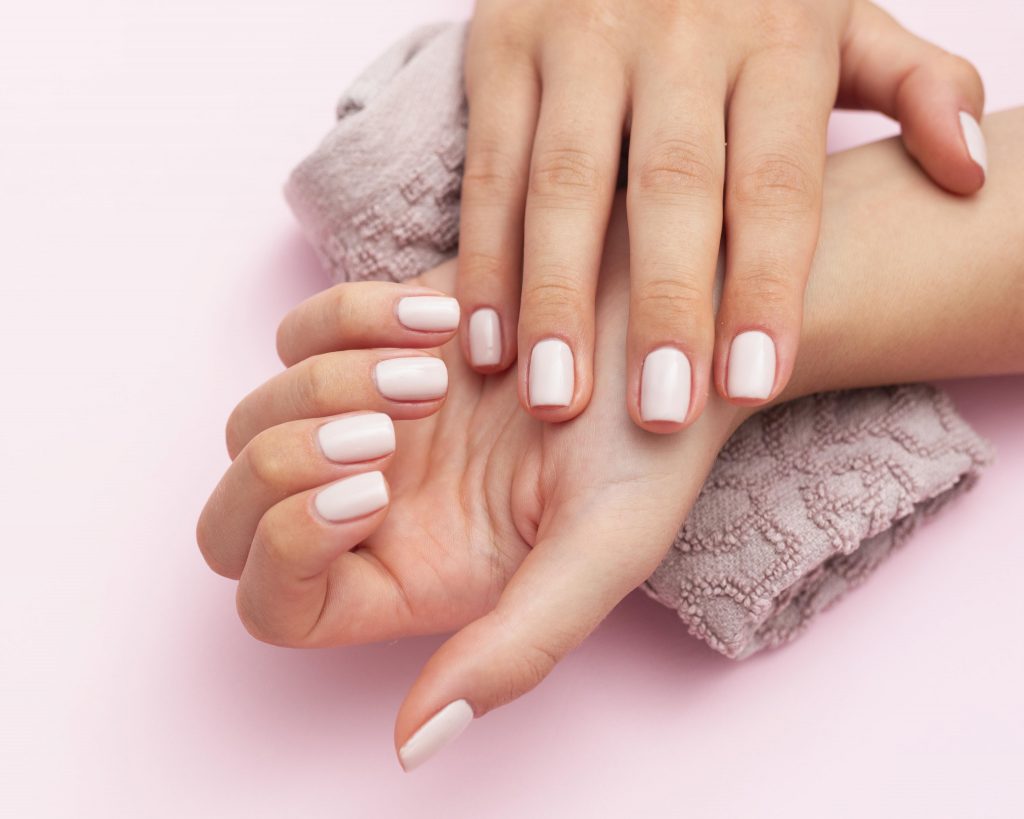
In conclusion, collagen consumption may helps with hair, nails, and skin condition since it is the building block of it. So, apart from practicing ‘prevention is better than cure’ measure once you have seen the symptoms in your hair, skin and nails, it is still not too late to help it with collagen.

Should you consider collagen supplementation?
Collagen is a fibre-like structure that is used to make connective tissue, which connects other tissues together. It is a major component of bone, skin, muscles, tendons, and cartilage. Collagen is a component that helps make tissue strong, resilient, and able to withstand stretching (1).
Although the saying that our bodies make less collagen as we age is true, the production of collagen drops most not only because of this but also due to excessive exposure to the sun, smoking, including secondhand smoke, excessive consumption of alcohol, lack of sleep, and lack of exercise. As the collagen levels in our skin diminish, the deep skin layers change from a tightly organised network of fibres to an unorganised maze. Environmental exposure to the skin, such as harsh weather, can also damage collagen fibres by reducing their thickness and strength, which can lead to wrinkles on the skin surface (1).
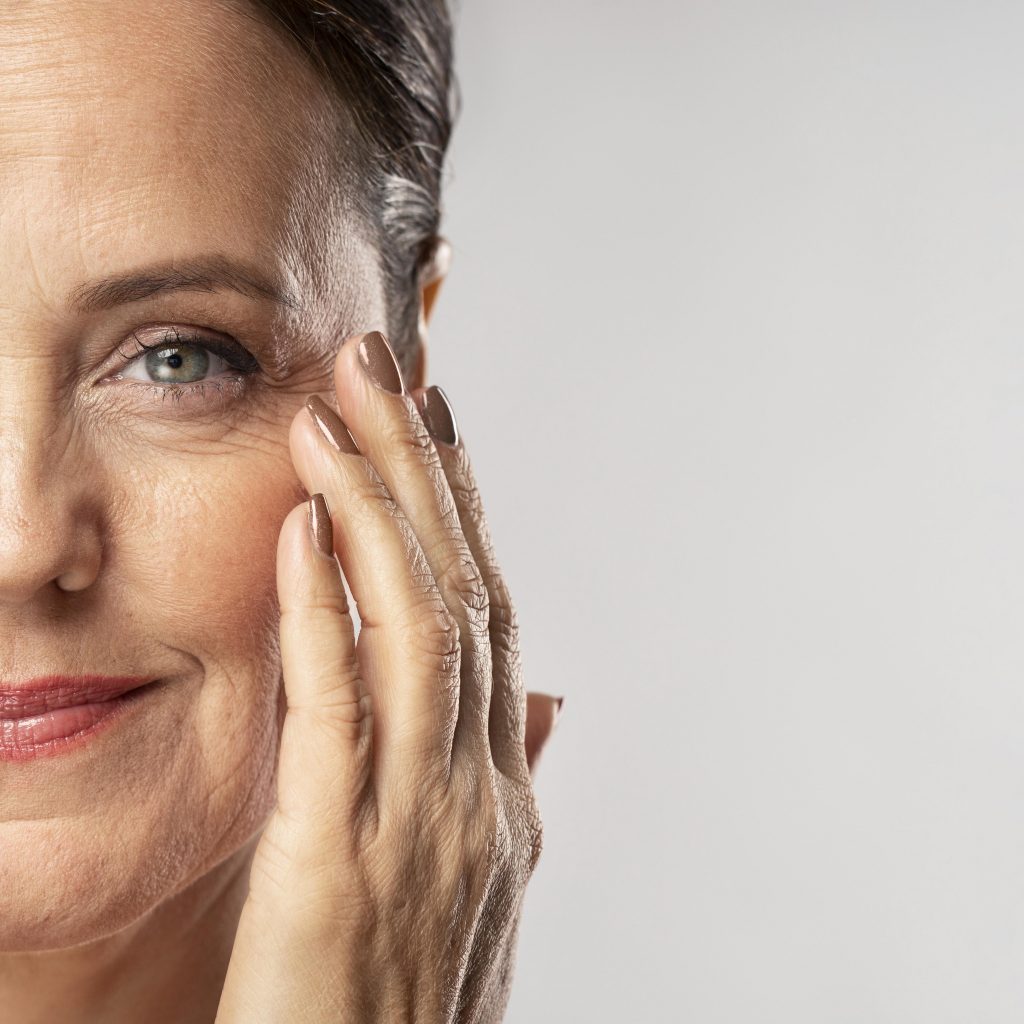
Research on collagen supplementation focuses mostly on joint and skin health. Although studies pertaining to this using human subjects are still lacking, some randomized controlled trials have found that collagen supplementation improves skin elasticity. In one study, women who took a supplement containing 2.5–5 grammes of collagen for 8 weeks experienced less skin dryness and a significant increase in skin elasticity as compared to those who did not. Another study found that women who consumed it for 12 weeks experienced increased skin hydration and a significant reduction in wrinkle depth as compared with a control group (1, 2, 3, 4).
Trials on collagen supplements and joint health also found that they can improve joint mobility and decrease joint pain in people with osteoarthritis or in athletes (5). Collagen comprises about 60% of cartilage, a very firm tissue that surrounds bones and cushions them from the shock of high-impact movements, so a breakdown in collagen could lead to a loss of cartilage and joint problems.

Other than the consumption of collagen-based supplements, there are also foods that are rich in collagen or that encourage collagen production other than the lifestyle modifications mentioned above. foods such as tough cuts of meat full of connective tissue like pot roast, brisket, and chuck steak. However, a high intake of red meat is not recommended as part of a long-term healthy diet. Collagen is also found in the bones and skin of freshwater and saltwater fish. Bone broth, which requires animal bones to simmer in water with a small amount of vinegar for 4–24 hours, is also said to have high collagen properties. However, the amount of amino acids will vary among batches depending on the types of bones used, the cooking period, and many other factors. Other foods that can help with the production of collagen are foods that are rich in zinc, such as legumes, nuts, seeds, whole grains, and vitamin C-rich foods, such as citrus fruits, bell peppers, and tomatoes.

Although studies on the effectiveness of collagen for health are still lacking, many available studies have not shown negative side effects in individuals given collagen supplements (6). Thus, it is worth trying for its said benefits, especially if the benefits are your health concerns! But be sure to talk to your healthcare professionals about this based on your medication intake and your health issues before consuming any health supplement.
References
- Harvard T.H. Chan. School of Public Health. Collagen.https://www.hsph.harvard.edu/nutritionsource/collagen/
- Healthline. Top 6 Benefits of Taking Collagen Supplements. https://www.healthline.com/nutrition/collagen-benefits
- Proksch E, Segger D, Degwert J, Schunck M, Zague V, Oesser S. Oral supplementation of specific collagen peptides has beneficial effects on human skin physiology: a double-blind, placebo-controlled study. Skin Pharmacol Physiol. 2014;27(1):47-55. doi: 10.1159/000351376. Epub 2013 Aug 14. PMID: 23949208.https://pubmed.ncbi.nlm.nih.gov/23949208/
- Borumand, M., & Sibilla, S. (2015). Effects of a nutritional supplement containing collagen peptides on skin elasticity, hydration and wrinkles. Journal of Medical Nutrition and Nutraceuticals, 4(1), 47.https://www.jmnn.org/article.asp?aulast=Borumand&epage=53&issn=2278-1870&issue=1&spage=47&volume=4&year=2015
- Bello AE, Oesser S. Collagen hydrolysate for the treatment of osteoarthritis and other joint disorders: a review of the literature. Current medical research and opinion. 2006 Nov 1;22(11):2221-32.
-
Kim DU, Chung HC, Choi J, Sakai Y, Lee BY. Oral intake of low-molecular-weight collagen peptide improves hydration, elasticity, and wrinkling in human skin: a randomized, double-blind, placebo-controlled study. Nutrients. 2018 Jul;10(7):826.
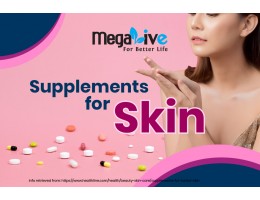
Supplement For Skin
There are many supplements on the market formulated for various purposes. Knowing what to look for in your supplements help you make a better choice in choosing supplements for your health, here we share some of the tips in choosing supplements for your skin!
Vitamin C and antioxidants
Vitamin C has many functions in the body, including function related to the skin health. It acts as a co -factor in collagen to stabilize the collagen structure on the skin. Vitamin C is required in the formation of an enzyme which is essential in forming collagen, which explains why sufficient consumption of vitamin C helps with wrinkle free looking skin due to the formation of collagen.
When choosing vitamin C supplementation, it is best to choose natural vitamin C, that derived from plant based vitamin C rich foods such as guava, berries, orange, pomegranate, etc., this will give better absorption of skin as compared to synthetic vitamin C to the body and will also give various function of antioxidants properties to overall body health not only skin!
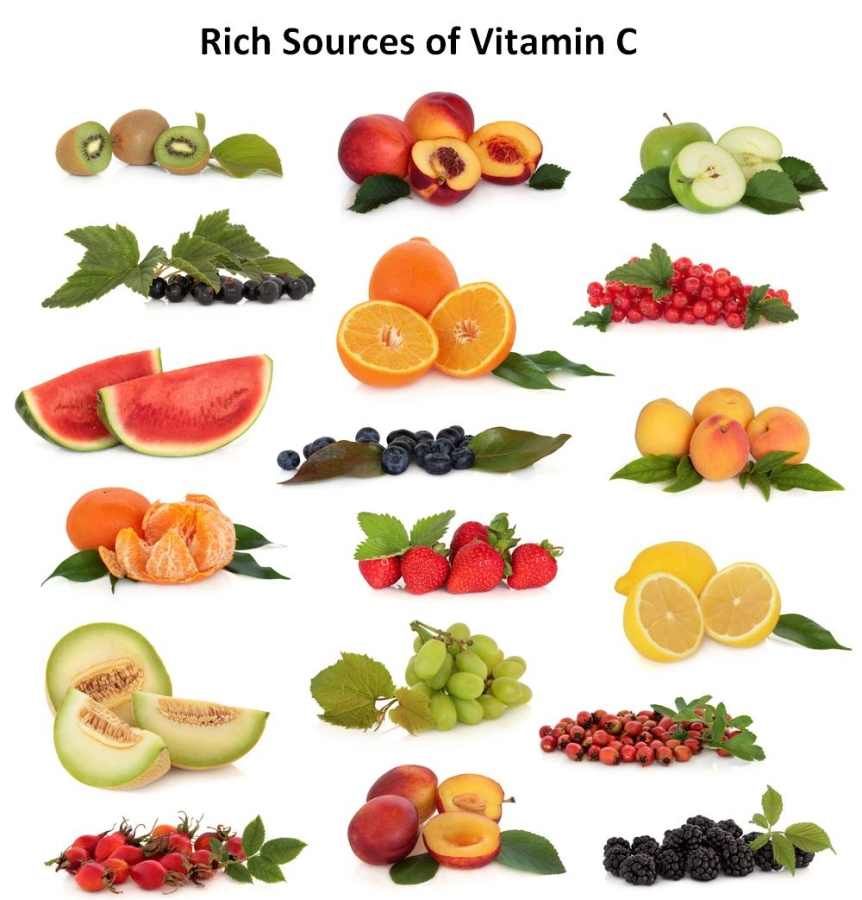
High dosage of vitamin C, does not necessarily means that it is better. We are recommended to consume about 70 mg of vitamin C daily according to the Ministry of Health. It can be consumed from fruits, vegetables, and fortified food, however, for certain people it is hard to consume fruits and vegetables on daily basis due to various reasons. Thus consumption of vitamin C from supplement can be used as an alternative.
Omega 3 Fatty Acids
Omega 3 fatty acids are usually referring to as good fat. It serves to regulate the skin’s oil production, improved balance hydration, subdue breakout and minimize signs of aging. Furthermore, it can also help to soften rough, dry skin, and have a soothing effect on irritation and dermatitis if apply topically. Omega 3 rich foods can improve the composition of skin by balancing its inflammatory response towards the effect of sun damage and also improve sensitive skin condition by making it less dehydrated and dry.
Omega 3 rich foods can be found in food such as cat fish, terubok fish, patin fish, mackerel, spinach, mustard green, tofu and tempeh. People who consume lack of fish in their diet or who does not consume fish at all are at risk of lacking omega 3 nutrient (DHA & EPA) in their body. Thus, should actually obtain this from supplement.

When choosing supplement with omega 3, it is important to make sure that the supplement has enteric coated technology which will allow the nutrients to metabolize at its designated place that is small intestine and will not be broken down by stomach acid. A good Omega 3 supplementation also must undergo molecular distillation process to avoid any contamination such as mercury contamination from the fish oil source.
Collagen
Our body can produce its own collagen, however the production of collagen gradually declined as we aged, which explains among the sign of aging is wrinkles, that is coming from skin that is less elastic, supple, and firm. We can get collagen from food and there are also foods which can stimulate production of collagen and break down existing collagen. Body makes collagen from combining proline and glycine (types of protein).Thus consuming food high with proline and glycine will help with restoring collagen level in the body.
Foods that are high with collagen are mostly diet from protein-rich foods such as bone broth, pork, chicken, beef, eggs, and fish. Plant based food also have added benefits to collagen rich food consumption since vegetables and fruits contain high level of antioxidants which can protect oxidative stress from reducing collagen.

Apart from these, you may consume collagen supplement for maintenance of your skin health and help with slowing wrinkle formation. It is hard to identify criteria for good collagen supplementation, but among things that one need to consider in choosing collagen supplementation is the other ingredients combining with it and for what purposes. Since combination of collagen with other ingredients might increase its bioavailability and making it has more functions not only to skin but also to overall body health.
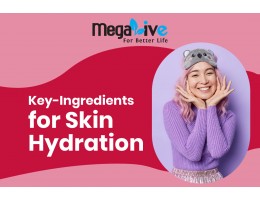
Key -ingredients for skin hydration
In general, there are three main types of skin conditions: oily skin, dry skin, and combination skin. Skin experts believe that each skin condition requires a specific level of hydration to maintain its healthy state.
A wide variety of products are available in the market, specially formulated to moisturize and hydrate the skin. However, it's essential to understand the distinction between moisturizing and hydrating the skin.
Hydrating ingredients are substances that can add water to the skin. These ingredients have the unique ability to draw moisture into the skin's layers.
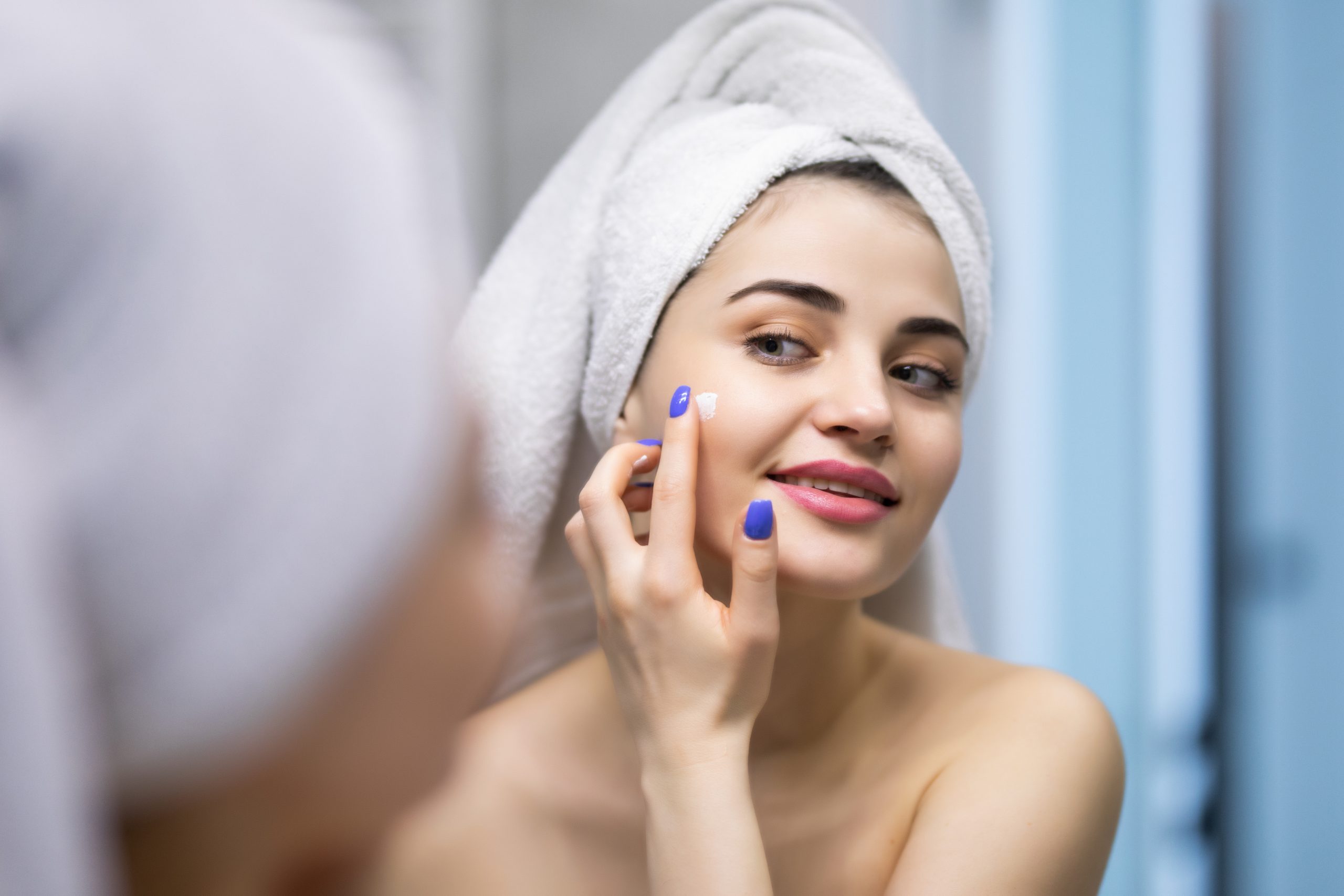
On the other hand, moisturizing ingredients are substances that help retain the skin's hydration by preventing Trans-Epidermal Water Loss (TEWL). TEWL is a process that leads to the evaporation of water from the skin.
Dry skin requires both hydrating and moisturizing ingredients to maintain its moisture and overall health. Conversely, for oily and combination skin types, the choice of skincare products should depend on the specific skincare regimen, ingredients, and the particular areas of the skin.
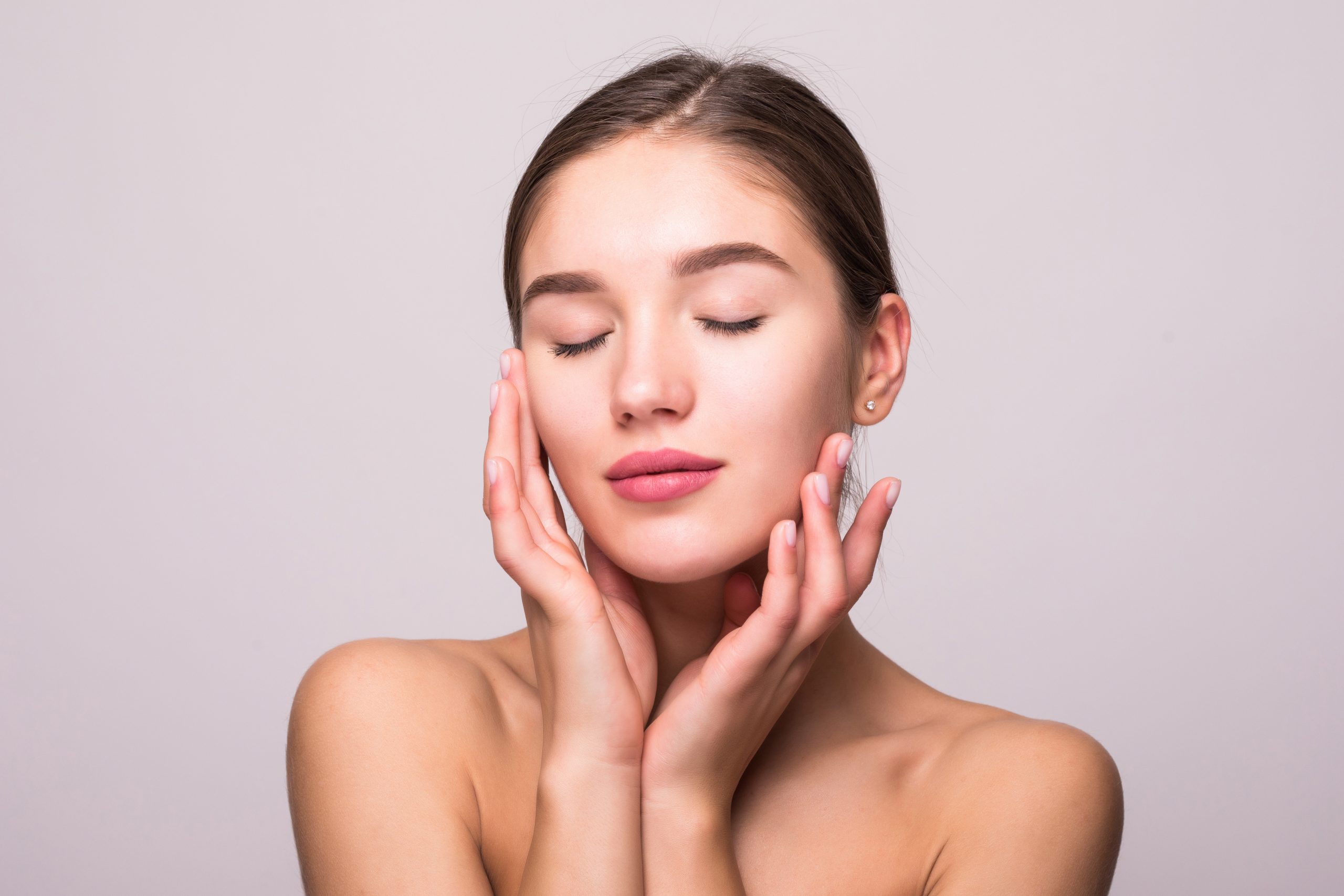
In summary, there are three primary categories of hydrating and moisturizing ingredients available in the market: humectants, emollients, and occlusives.
-
Humectants: These ingredients attract and retain water and moisture in the skin. They work by drawing water from the dermis into the epidermis. Examples include Glycerin, Honey, Hyaluronic Acid, Panthenol, Propylene Glycol, Butylene Glycol, and Hydroxy Acids like Glycolic Acid and Lactic Acid.
-
Emollients: Emollients are substances that enhance the skin's texture by filling the gaps between skin cells. They provide lubrication and impart a soft, smooth feel to the skin. Some common emollients are Dimethicone, Isopropyl Palmitate, Squalene, Ceramide, and Isopropyl Isostearate.
-
Occlusives: Occlusives form a protective barrier on the skin's surface, reducing Trans-Epidermal Water Loss (TEWL) and preventing water from evaporating into the environment. Examples include Mineral Oil,Lanolin Acid, and Lanolin.
Additionally, a newly discovered ingredient that has gained popularity in the skincare industry is ceramide. Many skincare companies have started incorporating ceramides into their formulations. Studies have shown that applying ceramides for just 24 hours can significantly reduce Trans-Epidermal Water Loss, a crucial indicator of skin hydration.
Furthermore, research has explored the relationship between oral consumption of ceramides and improvements in skin condition. Surprisingly, it has been found that consuming ceramides for 12 weeks can be especially beneficial for dry skin conditions when compared to a placebo.
Studies on the safety of ceramide consumption have concluded that ceramides are safe for oral consumption.
In conclusion, maintaining proper hydration and moisturization is crucial for healthy skin. A combination of emollients, humectants, occlusives, and ceramides is vital for maintaining the skin's barrier and moisture. Additionally, consuming supplements containing high antioxidant properties and ceramides can help improve skin condition.
References
- Tsuchiya, Y., Ban, M., Kishi, M., Ono, T., & Masaki, H. (2020). Safety and Efficacy of Oral Intake of Ceramide-Containing Acetic Acid Bacteria for Improving the Stratum Corneum Hydration: A Randomized, Double-Blind, Placebo-Controlled Study over 12 Weeks. Journal of Oleo Science, 69(11), 1497-1508.
- Spada, F., Barnes, T. M., & Greive, K. A. (2018). Skin hydration is significantly increased by a cream formulated to mimic the skin’s own natural moisturizing systems. Clinical, cosmetic and investigational dermatology, 11, 491.
- Science Becomes Her. Emollients, Occlusives, & Humectants, Moisturized explained. https://www.sciencebecomesher.com/emollients-occlusives-humectants?




